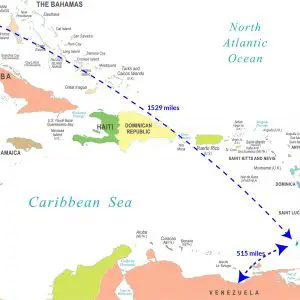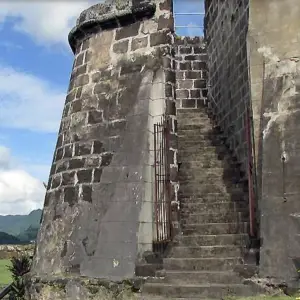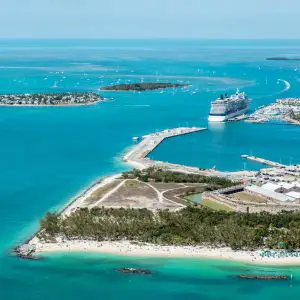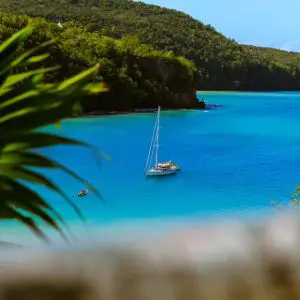If you are planning on visiting Grenada or at least want to learn more about this country and island, you will definitely want to learn more about its active submarine volcano. While ships have to stay fairly far away from the volcano as it is active and could risk eruption, it’s pretty cool to know that this is one of the only underwater active volcanos in the Lesser Antilles volcanic arc.
What is Kick ‘Em Jenny? Kick ‘Em Jenny is an underwater (submarine) volcano located six miles off the coast of Grenada and is one of the most active volcanoes in the region. It is located around 650 feet below the surface of the water, is 4,300 feet high, and 1,000 feet wide. The volcano was discovered in 1939 and since then has erupted over 13 times.
While you cannot explore the volcano or go over the summit as it is active and could lead to dangers with eruption, this submarine volcano is unique to this region because it’s the only one! This article will be your guide to all things about Kick ‘Em Jenny, including its history, geography and composition, and its future impact on the area.


Kick ‘Em Jenny’s Location
If you look around five miles north of the large island of Grenada, you can find Kick ‘Em Jenny. Grenada is one of the southernmost island countries in the Caribbean located just above Venezuela in South America. The volcano is north of the largest island in the country, which is also called Grenada.
Kick ‘Em Jenny is located in the Grenadines Island chain, which is in the Eastern Caribbean Sea. It is found in the Lesser Antilles volcanic arc, which is created by the converging of the American and Caribbean plates. This converging creates what is known as a subduction volcano as the volcanoes in this region are created by the meeting of plates.
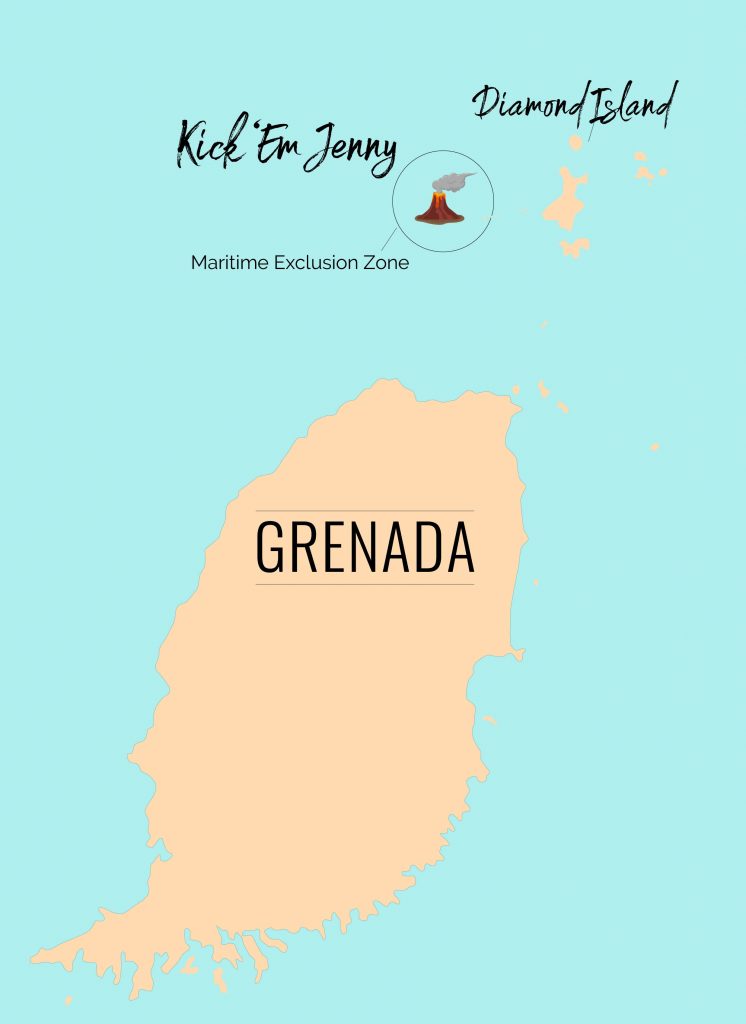
(Map is for illustration – not to scale)
Due to its activity, there is also a maritime exclusion zone that is managed by the Seismic Research Centre at the University of the West Indies, Trinidad. This zone is meant to protect ships from getting too close to the volcano. This zone is typically one mile from the center of the volcano and is raised to three with greater activity.
The exclusion zone is put in place for two main reasons in Grenada:
- To protect the shipping industry: Changes in water density near the volcanoes can be dangerous to ships as well as the expulsion of volcanic materials.
- Mitigate the risks and harms associated with tsunamis: Being too close to the volcano can lead to violent waves nearby and onshore.
Knowing the location of Kick ‘Em Jenny and its exclusion zone is crucial for ships and nearby inhabitants of Grenada so that they can make sure they are protected and staying safe, especially because the volcano could erupt. There are also other risks such as earthquakes and landslides that trigger large waves.
The Geography and Composition of Kick ‘Em Jenny
Kick ‘Em Jenny is a little under 650 feet below the surface of the water, creating a buffer between the volcano and the atmosphere, but still small enough to emit debris. From the floor of the ocean, the volcano is around 4,300 feet high, showing that this volcano sits in deep water in the Caribbean. Evolving eruptions have allowed the volcano to grow since inception.
The Smithsonian Institution Natural Museum of Natural History Global Volcanism Program reports Kick ‘Em Jenny is composed of these materials:
- Majority of the composition: Basalt and Picro-Basalt
- The rest of the composition: Andesite, Basaltic Andesite, and Dacite
These materials build on each other and lava and other volcanic material forms after eruptions occur.
There has been no recorded growth since the 1960s according to the University of the West Indies, which is good news for its impact above the water. The dome did collapse in the late 1980s, which created a deeper crater for eruptions to occur. This deeper crater means that the material has to travel further to get to the surface of the water.
Many of the islands near Grenada have been the result of submarine volcano eruption and growing above the surface of the water over time. While there is no current growth of Kick ‘Em Jenny, continued eruptions could result in it forming into an island in the very distant future. Imaging of the seafloor is the only way to show this growth and changes made to the area.
Fully recording and interpreting the findings of Kick ‘Em Jenny’s geography and composition, as well as eruptions, is difficult because it is located beneath the surface. Submarine volcanos are much more challenging to study than those above ground, making research much more limited.
According to USGS, submarine volcanoes are unique from those above ground in many ways including:
- The water surrounding the volcano results in eruptions that are categorized by steamy and violent explosions that can launch material high into the air.
- The interaction of water and lava creates larger amounts of debris as the material cools quickly. This reaction can be violent and spread volcanic material.
- The debris that accumulates can increase the size of the volcano or settle nearby, changing the geography of the seafloor over time.
While there are key differences that are related to the reaction of seawater with the volcano, they look very similar structurally to volcanoes located on the surface.
Kick ‘Em Jenny’s Activity History
It is unclear how long Kick ‘Em Jenny has been active, but it was first discovered in 1939 due to an eruption that created an ash cloud above the surface. Since then, there have been at least 13 known eruptions. This number could be higher, but unknown to researchers if they are small enough not to be felt or observed.
The first eruption was able to produce an ash cloud and small tsunamis, being felt from shore in north Grenada, but not causing any injuries or damage. The recorded eruptions are measured by acoustic waves that are recorded using ocean wave instrument technology. Of these wave detections, only a few of them have actually left absolute evidence of volcanic activity.
These acoustic waves are called T-phase acoustic waves, and they can be triggered by a variety of reasons:
- Reactions between lava and seawater: This can be during an eruption or small movements in lava that creates enough pressure to create T-phase waves.
- Landslides: Underwater landslides can occur, causing major movements in the geography of the area and initiate large waves.
- Earthquakes: The plates that converge beneath the water’s surface to form the volcano also create friction against one another and can cause earthquakes that register on the wave scale.
All of these factors coupled together can increase the likelihood of T-phase acoustic waves, but not necessarily be the result of a volcanic eruption. There have been a few noted eruptions, recorded by the Volcano Discovery, that I want to highlight as they are definitely confirmed to have been volcanoes:
- 1939 Eruption: This is the first recorded eruption that notified scientists that Kick ‘Em Jenny exists. Small tsunamis, clouds of ash, volcanic rock materials, and volcanic gas were all released.
- 1974 Eruption: Changes in the color of the water, volcanic material, and changes in the water surface were visible during this eruption.
- 1988 Eruption: Similar to the eruption in 1974, small changes in the ocean’s appearance as well as dispelling of small amounts of volcanic material suggested an eruption occurred.
- 2017 Eruption: This is the most recent known eruption of Kick ‘Em Jenny.
The remaining eruptions are only known due to detection technology rather than physical evidence. This could mean that other factors (besides eruption) could be involved.
The Impact of Kick ‘Em Jenny
As mentioned earlier, the maritime exclusion zone is in place to protect people from the effects of the volcano. This includes both impacts of the volcano when it erupts and the emissions that are released when the volcano is dormant. Being aware of these impacts can help visitors and residents of the region protect themselves from potential dangers.
The following scenarios are a few of the outcomes that could occur when Kick ‘Em Jenny erupts again.
What Happens if Kick ‘Em Jenny Erupts?
An eruption can lead to many risks to vessels in the nearby water as well as Grenada, especially if the eruption is large enough. The greatest risk of Kick ‘Em Jenny is that there have been so few eruptions in its short-known history that scientists aren’t necessarily sure what it is capable of.
The biggest risks associated with the eruption of submarine volcanoes, if they are violent enough, include:
- Ash clouds: If these large clouds are large and thick enough, they may have negative environmental and health impacts on residents of Grenada who breathe in this air.
- Volcanic material: If Kick ‘Em Jenny grows closer to the surface of the water (it has not shown signs of growth in recent history), volcanic rocks that are launched during eruption can be sent over far distances above the water. This could be dangerous to planes and nearby islands.
- Tsunamis: The high pressure of the eruption can lead to significant waves that come to shore, potentially destroying structures and injuring people.
Researchers do not believe that these dangers will have a large impact anytime soon as the volcano has not grown recently. This could change over time, bringing the volcano closer to the surface, and increasing its impact as more eruptions occur.
Kick ‘Em Jenny and Tsunamis
Small tsunamis have occurred because of Kick ‘Em Jenny’s eruptions, which brings large waves to shore. Fortunately, these tsunamis have never become dangerous but could be larger in the future if seismic activity increases substantially.
A submarine volcano produces a tsunami when magma is released during an eruption, creating a crater called a caldera. The seawater and crater create enough pressure to produce incredibly large waves that can be dangerous to structures onshore if they are large enough. The only tsunamis that have occurred sent vibrations to Grenada and ash, but no damage.
Submarine landslides can also be responsible for the triggering of tsunamis. This is more likely than a tsunami caused by an eruption, but it can be just as dangerous if it is large enough. If the volcano’s dome were to collapse or a landslide occurs off of the volcano itself, this can initiate a tsunami with the movement of large sums of water.
It is very difficult to obtain exact information about these events occurring with the current technology and a short history of the volcano’s activity. The only evidence is from seafloor mapping, which can show historic changes in the surface of the seafloor. Because this evidence is difficult to gather, tsunamis can be caused by a variety of these volcano-related events.
Kick ‘Em Jenny and Buoyancy
The most immediate risks would be an eruption of a volcano and its emission of volcanic material and potential risks of large tsunamis. Risks are also associated with this submarine volcano when it is not erupting. The gases that are produced by the volcano can change the composition of the water and reduce buoyancy.
When gas bubbles are released from the volcano, the water density is lowered in these areas. If a ship passes over these areas, it is at risk of losing buoyancy and sinking. This occurs even when a volcano is not erupting, making It dangerous year-round.
Off Grid reports that this lack of buoyancy poses major risks to the shipping industry and could result in significant financial and human loss. Exclusion zones are put in place with this reason specifically in mind. During times of increased seismic activity, greater levels of gas can have larger impacts on these ships, and their ability to safely pass through the region.
Fun Facts about Kick ‘Em Jenny
Now that you know all about the interesting geography, noted eruptions, and the impacts of the volcano as it relates to the water’s surface and surrounding areas, let’s get to some more fun facts about Kick ‘Em Jenny.
You may not know these things about this special volcano:
- How did Kick ‘Em Jenny get its name? The surrounding islands and waterways located around the volcano are known to produce fairly rough waters. According to Geology.com, Kick ‘Em Jenny was initially used for the nearby island, now known as Diamond Island. When the volcano first erupted in 1939, the people began referring to it as Kick ‘ Em Jenny and somewhere along the way Diamond Island got its new name.
- How many people would be impacted by a large eruption? Fortunately, there limited numbers of people that live incredibly close to the volcano. If a large eruption occurs, it could still bring danger to nearby populations. Around 5,000 people live within 6 miles of the volcano, and over 70,000 live within 20 miles. There have been no reported deaths since its first eruption in 1939.
- What is the significance of the shipping industry in the area? As mentioned, changes in the gas can impact ship buoyancy. There are many ships that pass through the area as the volcano lies beneath the trade route between St. Vincent and Grenada. Because Grenada is an island, it needs many imports to serve the populations that live there.
- Are there any nearby volcanoes? Located right next to Kick ‘Em Jenny is her brother Kick ‘Em Jack. While it is an inactive volcano, its crater is located less than 2 miles away. There are no other active submarine volcanoes in the area, but there are dormant land volcanoes. Mount Saint Catherine is located on the largest island of Grenada and is the largest of the nearby volcanoes in the region. It has had no eruptions is known history.
- What makes Kick ‘Em Jenny particularly special? Beyond the fact that an underwater volcano is a cool natural occurrence, this specific volcano is helping researchers and scientists, like those at the National Oceanic and Atmospheric Administration, better understand these types of volcanos. It is particularly insightful in understanding how submarine volcanos transform into above-ground islands. The early 2000s saw lots of voyages to the volcano to conduct this research.
Kick ‘Em Jenny is an interesting volcano near Grenada because of its submarine nature and unpredictability in how it will impact the nearby populations. Its unknown behaviors over time could dramatically change its own geography and its ability to rise above the surface to create an island like many of the other islands nearby.
Grenada’s Kick-Ass Volcano
Because the volcano is located beneath the surface, many people do not even know that it exists! Even researchers continue to see it as a mystery because it is difficult to study and even more difficult to predict. This submarine volcano has a lot of moving parts that result in disruptions in the water, including eruptions, landslides, earthquakes, and tsunamis!
While you cannot go and see it for yourself due to exclusion zones and potential dangers, its ability to create rough waters and changes nearby make its presence known. Researchers may still have a difficult time understanding when events will happen, but the volcano has allowed for great strides in submarine volcano research for formations worldwide!


